|
What is Dry Eye Syndrome? It is the condition of having dry eyes. Dry eye syndrome is a common eye disease. It affects 5-34% of normal population. Among older people it affects up to 70% . Symptoms of Dry Eyes? Irritation, redness, discharge, and easily fatigued eyes. Blurred vision may also occur, discomfort and sensitivity to bright light. The symptoms can range from mild and occasional to severe and continuous. A PATIENT WITH SEVERE DRY EYES What Are the Causes of Dry Eye Syndrome? Tears have three layers. There’s the oily outer layer, the watery middle layer, and the inner mucus layer. If the glands that produce the various elements of your tears are inflamed or don’t produce enough water, oil, or mucus, it can lead to dry eye syndrome. When oil is missing from your tears, they quickly evaporate and your eyes cannot maintain a steady supply of moisture. The causes of dry eye syndrome include:
Who Is at Risk for Dry Eye Syndrome? Dry eye syndrome is more common in people aged 50 and older. The majority of them are women, but the condition does occur in men. Women who are pregnant, on hormone replacement therapy, or going through menopause are more at risk. The following underlying conditions can also increase your risk:
How Is Dry Eye Syndrome Diagnosed? If your eyes feel dry and you suddenly find yourself unable to see as well as you used to, visit an ophthalmologist right away. After describing your symptoms, you’ll likely undergo tests that examine the amount of tears in your eyes, such as a slit lamp, or bio microscope, exam of your tears. For this test, your doctor will use a dye such as fluorescein to make the tear film on your eyes more visible. A Schirmer’s test may also be used to measure how quickly your eyes produce tears. This tests your rate of tear production using a paper wick placed on the edge of your eyelid. Your eye doctor also might refer you to a specialist. Which doctor they’ll refer you to depends on the underlying cause of your condition. For example, they can refer you to an allergist if you have chronic allergies. SHIRMER TEST FOR DRY EYES How Is Dry Eye Syndrome Treated? Artificial Tears Eye drops that increase your eye moisture are among the most common treatments for dry eye syndrome. Artificial tears also work well for some people. Lacrimal Plugs Your eye doctor might use plugs to block the drainage holes in the corners of your eyes. This is a relatively painless, reversible procedure that slows tear loss. If your condition is severe, the plugs may be recommended as a permanent solution. Medications The medication most commonly prescribed for dry eye syndrome is an anti-inflammatory called cyclosporine (Restasis). The drug increases the amount of tears in your eyes and lowers the risk of damage to your cornea. If your case of dry eye is severe, you may need to use corticosteroid eye drops for a short time while the medication takes effect. Alternative medications include cholinergics such as pilocarpine. These medications help stimulate tear production. If another medication is causing your eyes to become dry, your doctor may switch your prescription to try to find one that doesn’t dry out your eyes. Nutrition You need a well-balanced diet with enough protein and vitamins to keep your eyes healthy. Omega-3 essential fatty acid supplements are sometimes recommended to enhance the oil content of the eye. Usually, people need to take these supplements regularly for at least three months to see an improvement. Surgery If you have severe dry eye syndrome and it doesn’t go away with other treatments, your doctor may recommend surgery. The drainage holes at the inner corners of your eyes may be permanently plugged to allow your eyes to maintain an adequate amount of tears. Home Care If you tend to have dry eyes, use a humidifier to increase moisture in the room and avoid dry climates. Limit your contact lens wear and the time you spend in front of the computer or television. Long-Term Outlook Dry eye syndrome usually doesn’t permanently affect your vision. You can considerably decrease your discomfort with treatment. In rare cases, eye infections and ulcers can occur and will need to be treated separately.
184 Comments
|
CategoriesArchives |
|
Copyright © Eye Health Clinic. All rights reserved.
|


 RSS Feed
RSS Feed